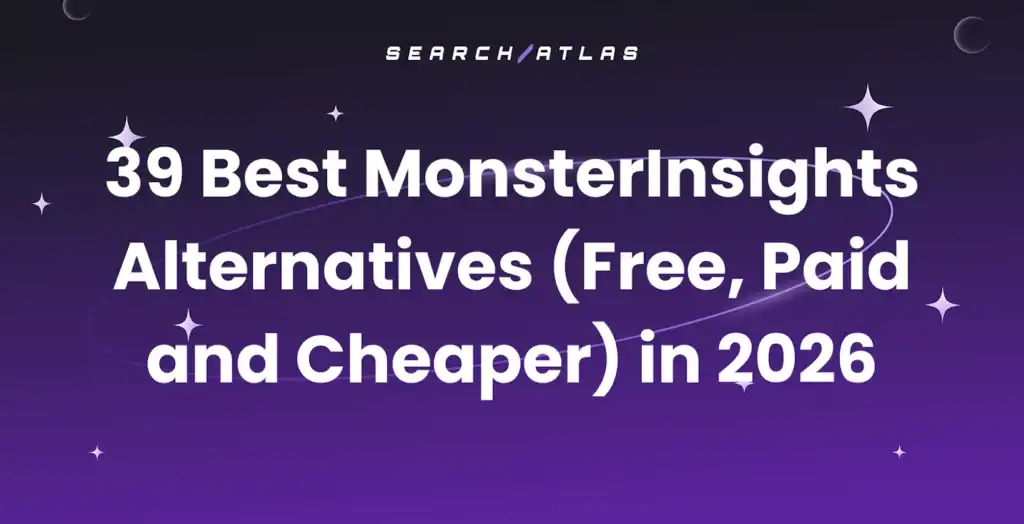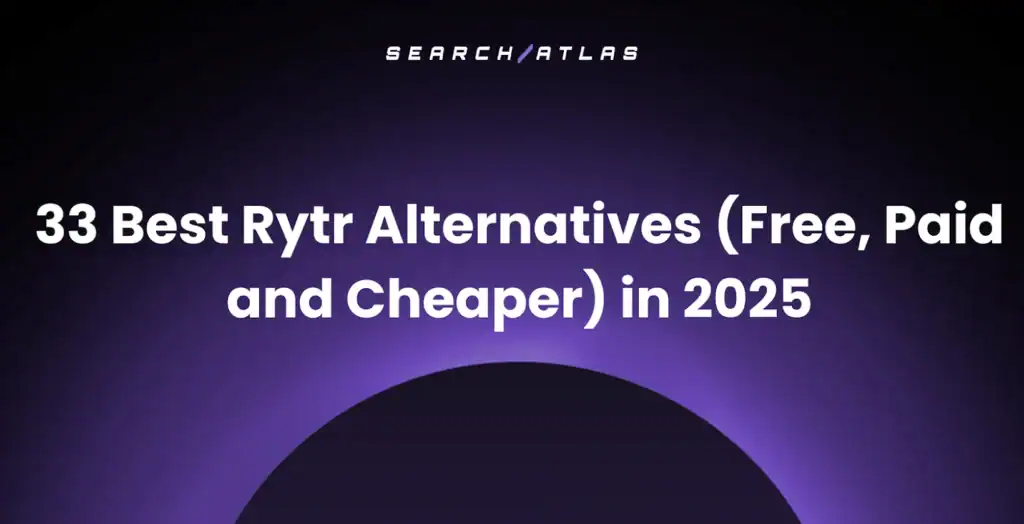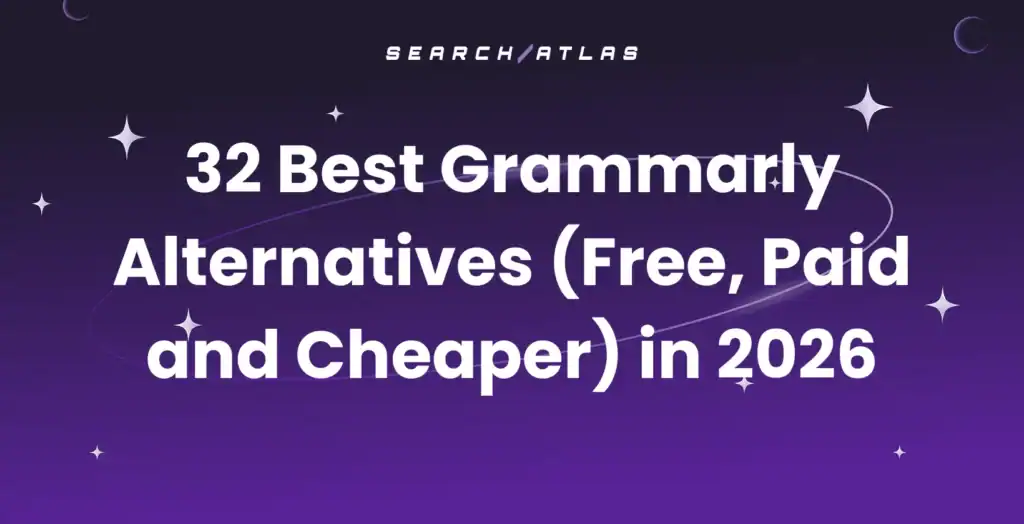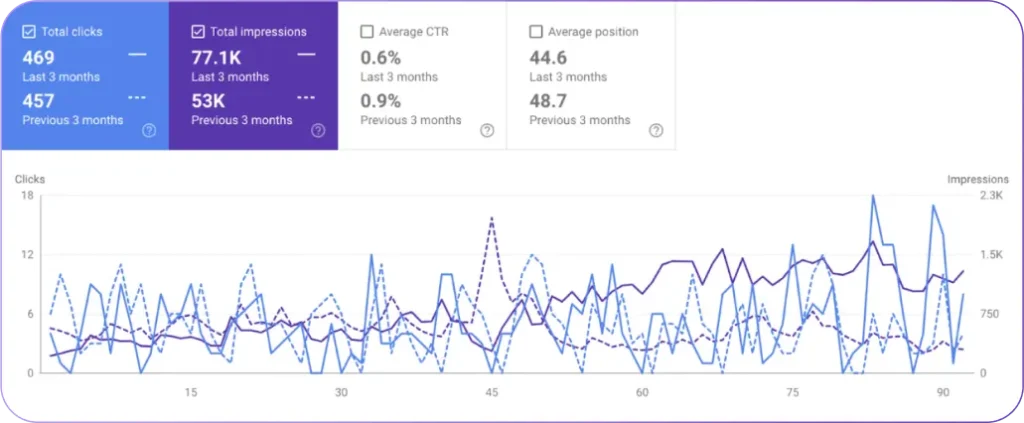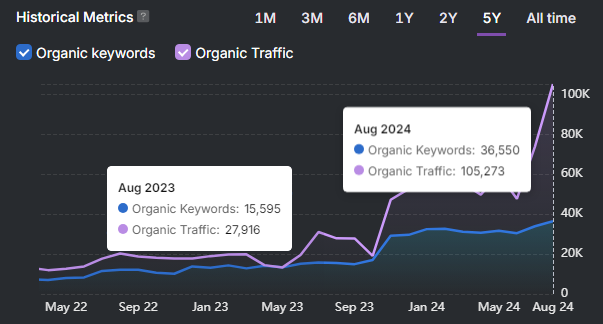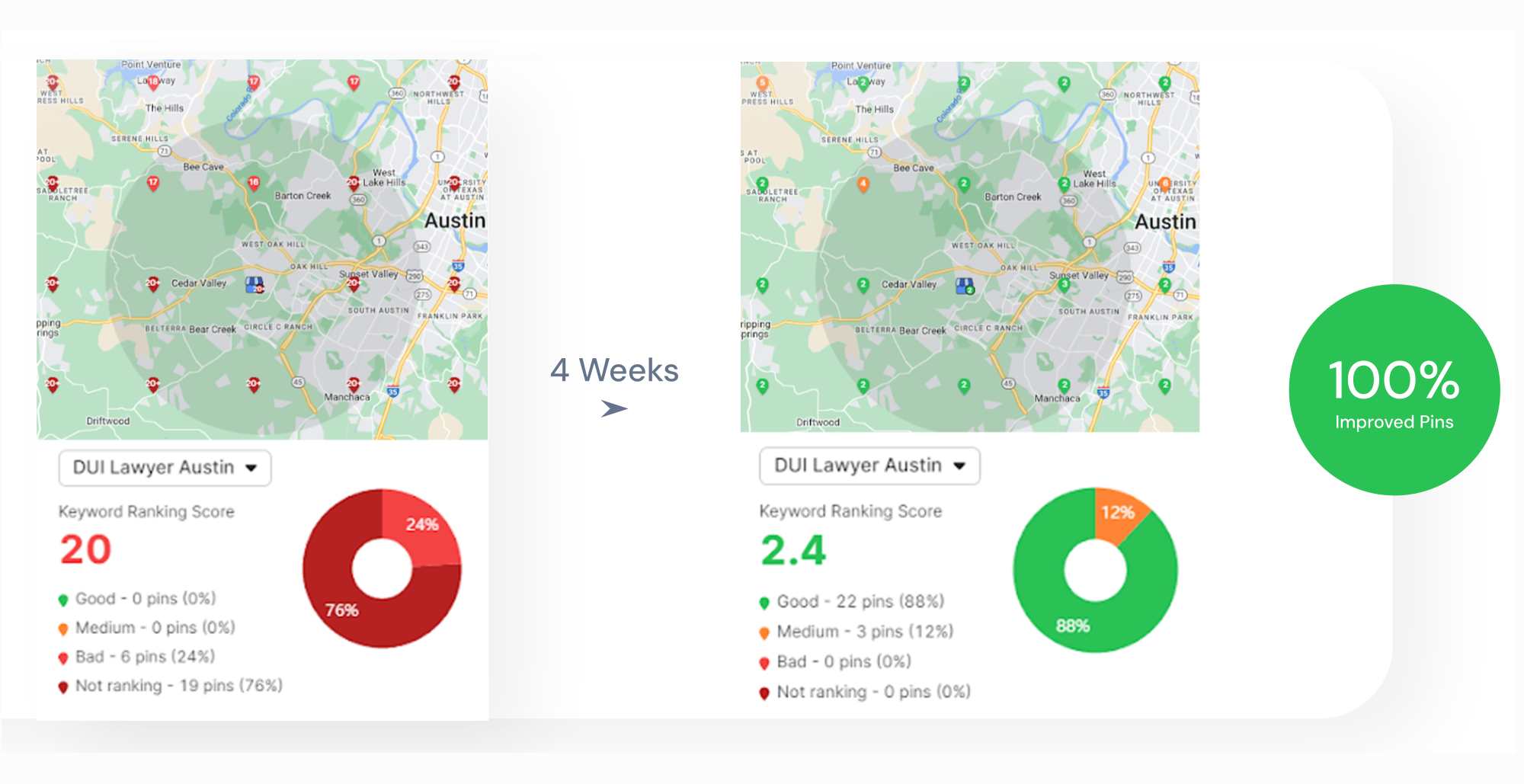Screaming Frog SEO Spider is a desktop website crawler that performs technical SEO audits by scanning websites to analyze structure, detect broken links, duplicate content, and missing metadata. The Screaming Frog SEO tool integrates with Google Analytics (GA4), Search Console (GSC), and PageSpeed Insights for performance metrics. The Screaming Frog SEO Spider review shows it handles small and large sites with real-time crawl results, JavaScript rendering, and supports multiple user-agents, including Googlebot and Bingbot.
Key features include core crawling with breadth-first algorithm, technical SEO auditing for broken links and redirects, and content analysis with AI-powered semantic similarity detection. Screaming Frog reviews show pricing starts with a free version limited to 500 URLs, while the paid version costs $279 annually for unlimited crawling. The main advantage is precise technical analysis that mimics Googlebot with API integrations, while the primary drawback is its steep learning curve.
What is Screaming Frog?
Screaming Frog is an SEO agency known for its SEO tool, Screaming Frog SEO Spider. It provides services which include Search Engine Marketing, Search Engine Optimisation, Pay Per Click, Paid Social Media, Technical SEO, Content Marketing, Digital PR, Reactive PR, and Link Building.
What is the Screaming Frog SEO Spider?
Screaming Frog SEO Spider is a desktop-based website crawler developed by Screaming Frog, which performs technical SEO audits and scans websites to analyze their structure. Screaming Frog SEO Spider detects broken links, duplicate content, and missing metadata. It collects on-site elements and flags issues that harm search performance. The spider handles both small and large sites and shows crawl results in real time. It supports JavaScript rendering and evaluates dynamic content, hreflang, canonicals, and orphan pages.
The tool integrates with Google Analytics, Google Search Console, and PageSpeed Insights. These connections add performance metrics, index status, and UX data. Users generate XML sitemaps, audit redirects, and review indexing rules through the spider. The tool includes a user-agent switcher that allows users to crawl as Googlebot, Bingbot, mobile, or custom bots.
What is the History of Screaming Frog?
Graeme founded one of the UK’s original search marketing agencies in 1998. He hired Jason as the first team member, and Dan joined the team in 2005. The agency was eventually sold to a pan-European marketing group.
Dan left in 2010 to work as an SEO consultant under the name Screaming Frog, inspired by a frog that defended itself against two cats in Dan’s garden. Graeme, Jason, and Dan decided to work together again and incorporated Screaming Frog. Matt Hopson joined as an original team member. The team established its first office in Henley-on-Thames.
The SEO Spider development started in 2010. The SEO Spider was released publicly with free and paid versions. The company grew from 8 team members in 2011 to nearly 40 by 2017. The team released a Mac version of the SEO Spider in 2011. The company won multiple UK Search Awards from 2012 to 2019.
The company launched the Log File Analyser in 2016 and a hybrid storage engine for the SEO Spider in 2018. The 2019 updates included the first structured data validator. Today, Screaming Frog operates as both an SEO agency and software developer.
Who is the Screaming Frog Tool for?
Screaming Frog SEO Spider is used by digital marketers, technical SEO specialists, SEO professionals, agencies, webmasters, site owners, e-commerce businesses, content publishers, and web development firms who need to crawl websites and gain insights into their structure, content, and performance.
What are the Screaming Frog Features?
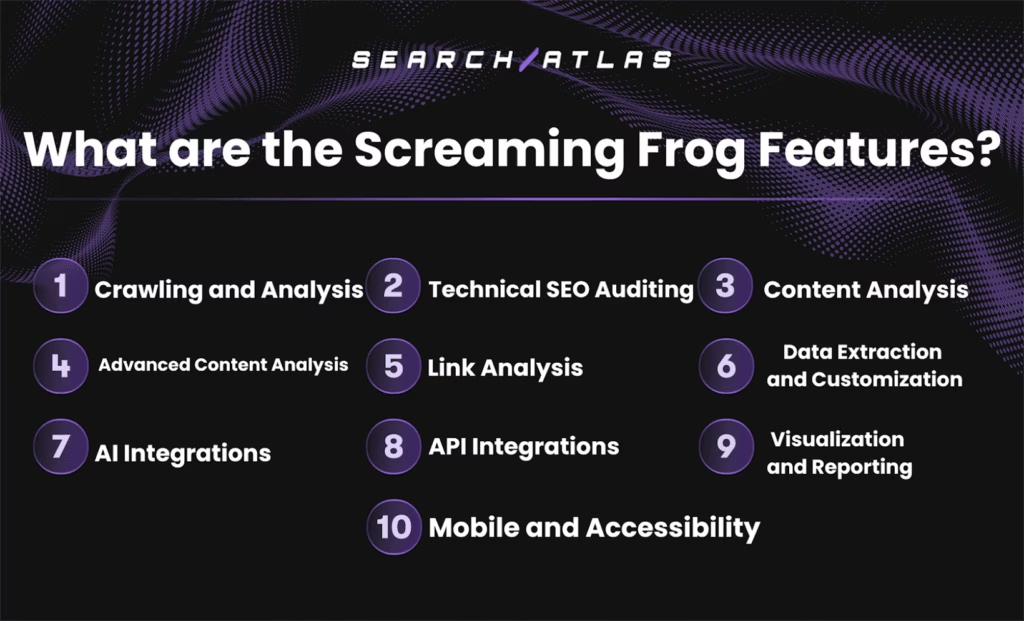
Screaming Frog features mostly revolve around technical SEO. Screaming Frog features are explained in more detail below.
1. Core Crawling and Analysis
Screaming Frog SEO Spider provides comprehensive core crawling capabilities, which enable systematic website examination. The tool uses a breadth-first algorithm to discover and follow hyperlinks in HTML systematically. It displays crawl results in real-time as it processes each page, allowing users to monitor progress continuously.
The spider supports both small websites with hundreds of pages and large enterprise websites with millions of URLs. A hybrid storage engine manages this scalability by storing data in both RAM and disk storage when needed for optimal performance.
The tool renders JavaScript-rich frameworks through Chromium WRS after JavaScript execution is complete. It processes Angular, React, and Vue.js websites by crawling the rendered HTML, capturing dynamic content that traditional crawlers miss.
Users switch between different user agents during crawling. The tool imitates Googlebot, Bingbot, Yahoo Slurp, mobile user-agents, or custom user-agents that users define. Custom HTTP headers enhance crawling flexibility by supplying header values in requests, including Accept-Language settings and cookie information.
The spider handles form-based authentication to access protected website areas by processing user credentials. Custom robots.txt testing allows users to download, edit, and test robots.txt files before crawling begins.
Additional core metrics include crawl depth tracking, response time monitoring, and last-modified header analysis. These fundamental crawling capabilities provide the foundation for all subsequent technical SEO analysis functions.
2. Technical SEO Auditing
Screaming Frog provides comprehensive technical SEO auditing capabilities that identify and resolve critical website issues. The spider finds broken links by crawling websites instantly and identifying 404 errors and server failures. This feature prevents user frustration and maintains search engine trust by locating pages that return client errors or server problems. Users export the broken link list with source URLs to developers for quick fixes, improving site reliability and user experience.
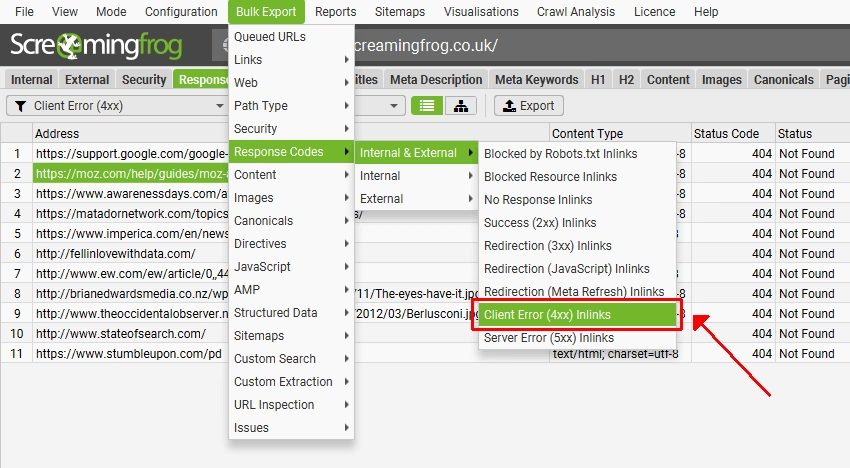
The tool audits redirects by detecting temporary and permanent redirects, including redirect chains and loops. This prevents link equity loss and ensures proper page authority transfer between URLs. Users identify redirect chains that slow page loading and fix loops that prevent proper crawling, optimizing site performance and search engine accessibility.
The spider reviews robots and directives by viewing blocked URLs and examining directives like ‘noindex’, ‘nofollow’, and canonical tags. This ensures search engines index intended pages while blocking unwanted content. Users audit meta robots directives to confirm important pages remain indexable and check canonical implementation across duplicate content sections.
Canonical tag analysis examines canonical link elements and HTTP headers for proper implementation. This consolidates duplicate content signals and prevents keyword cannibalization issues. Users verify that canonical tags point to preferred versions and identify missing canonicals on parameter-heavy e-commerce sites.
The tool audits hreflang tags by checking missing confirmation links, inconsistent language codes, and non-canonical hreflang implementation. This ensures international websites display the correct language versions to users. Users validate hreflang reciprocity between language versions and fix incorrect country codes, which confuse search engines.
Security issue detection discovers insecure pages, mixed content, insecure forms, and missing security headers. This protects user data and maintains search engine rankings. Users identify HTTP pages on HTTPS sites and implement proper security headers to meet modern web standards.
3. Content Analysis Capabilities
Screaming Frog provides content analysis capabilities that optimize on-page elements for search engines and users. The spider analyzes page titles and metadata by reviewing page titles and meta descriptions for issues like length, duplicates, or missing tags. This ensures proper SERP display and prevents ranking issues caused by inadequate metadata. Users identify pages with missing title tags, duplicate descriptions across multiple URLs, and titles exceeding Google character limits to improve click-through rates.
Meta keywords extraction captures meta keyword tags from pages for reference purposes. This provides historical data for legacy systems and regional search engines, which still reference these tags. Users review meta keywords on older websites during migration projects and maintain consistency for markets where these tags remain relevant.
Heading tags analysis examines H1 and H2 elements for missing, duplicate, or length issues. This improves content hierarchy and helps search engines understand page structure and topic focus. Users identify pages with multiple H1 tags, missing headings on important pages, and overly long headings.
Word count analysis measures the number of words on every page across the website. This identifies thin content pages and ensures adequate content depth for target keywords. Users spot product pages with insufficient descriptions, blog posts below competitive word counts, and landing pages requiring content expansion.
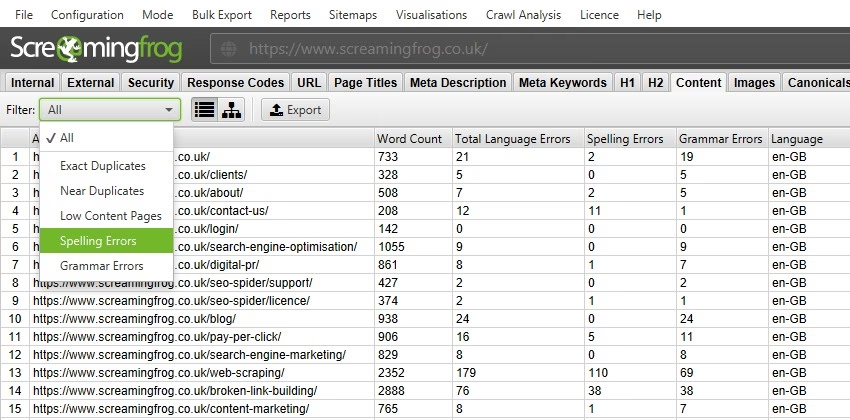
Spelling and grammar checks scan website content in over 25 different languages for errors. This maintains professional credibility and improves user experience across international markets. Users correct spelling mistakes on product pages, fix grammar errors in blog content, and ensure consistent language quality across multilingual websites. Spelling and grammar checks are available in the paid version only.
4. Advanced Content Analysis
Screaming Frog provides advanced content analysis capabilities through AI-powered features. Semantic similarity analysis using LLM embeddings uses machine learning to capture semantic meaning and relationships between words. This identifies similar pages with different phrases but overlapping themes, preventing content cannibalization and crawling inefficiencies.
Semantic similarity scores range from 0-1, with pages scoring above 0.95 considered semantically similar by default (adjustable down to 0.5). For example, users detect service pages describing identical offerings with varied terminology, blog articles covering the same topic from different angles, and category pages with overlapping product descriptions.
Content cluster visualization creates two-dimensional diagrams of URLs plotted from embedding data. This shows how semantically similar content clusters together. For example, users visualize fashion website clusters showing how shoes, accessories, and clothing naturally group, spot isolated help documentation requiring better navigation integration, and identify emerging product categories that need dedicated landing pages.
Semantic search functionality allows users to enter search queries and find the most relevant pages using vector embeddings rather than keyword matching. This mimics modern search engine behavior by calculating cosine similarity between queries and page content. For example, users discover relevant pages for keyword mapping projects, identify related content for strategic internal linking, and analyze how well their content matches target search queries compared to competitors.
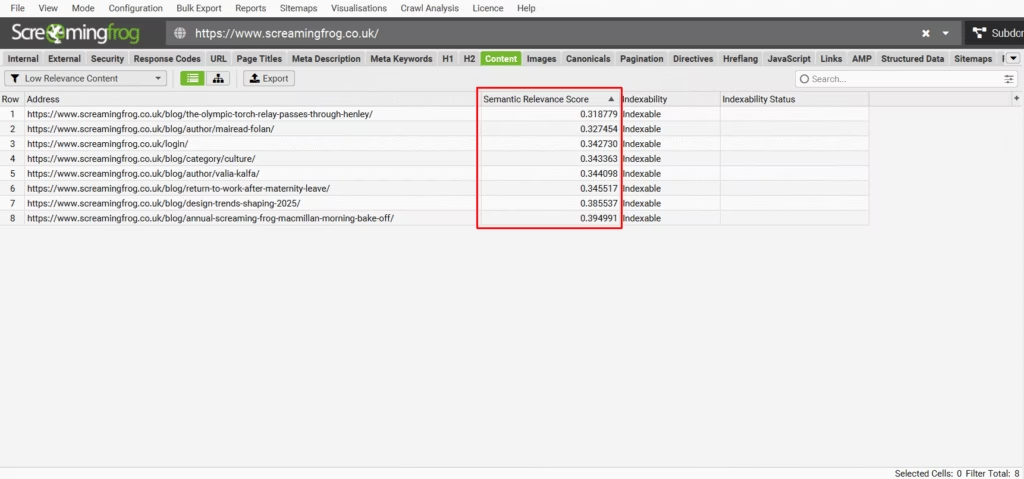
Low-relevance content detection works by averaging embeddings of all crawled pages to identify the site’s content centroid, then measuring how far individual page embeddings deviate from this average. Pages falling below the relevance threshold indicate off-topic content that dilutes topical authority. For example, users identify corporate press releases on product-focused sites, outdated promotional content no longer aligned with business direction, and legacy pages from previous company iterations.
Additional strategic applications include URL mapping for website migrations by crawling old and new sites together to find semantically similar redirect targets, improving internal linking between semantically related content using the duplicate details analysis, and performing semantic analysis of specific page elements like titles or meta descriptions rather than full page content.
5. Link Analysis
Link analysis in Screaming Frog provides comprehensive insights into website link structures. The tool calculates Link Score, a metric that determines how relevant a page is compared to other pages on the same website. This calculation considers incoming links and other factors. This feature reveals underlinked pages that need more internal link equity for better search engine visibility.
The tool examines both internal and external links during crawls and displays detailed data in the Links tab. Users identify pages with missing anchor text, non-descriptive anchor text like ‘click here’, or images without alt text. The software also detects follow and nofollow link attributes and helps users understand which links pass authority.
Integration with third-party metrics providers like Majestic, Ahrefs, and Moz enhances analysis. This integration combines internal crawl data with external authority metrics. Users access domain authority, trust flow, and citation flow data alongside technical findings.
The Links tab might reveal that product pages have low Link Scores despite being important conversion pages after you crawl an e-commerce site. Users then export the All Inlinks data to identify these underlinked products and create internal linking strategies. The tool flags pages receiving only nofollow links, which impacts search engine discovery and indexing potential.
6. Data Extraction and Customization
Data extraction and customization in Screaming Frog transforms the tool from a basic crawler into a web scraping platform. This feature eliminates the need for separate scraping tools and provides comprehensive data collection alongside SEO analysis. Users extract any HTML element, attribute, or text pattern across entire websites and maintain crawl efficiency simultaneously.
The primary benefits include automated data collection at scale, customizable extraction rules, and real-time processing during crawls. Organizations save time and resources by implementing custom extractors instead of manual data collection. The feature integrates with existing SEO workflows and exports data directly to spreadsheets for analysis.
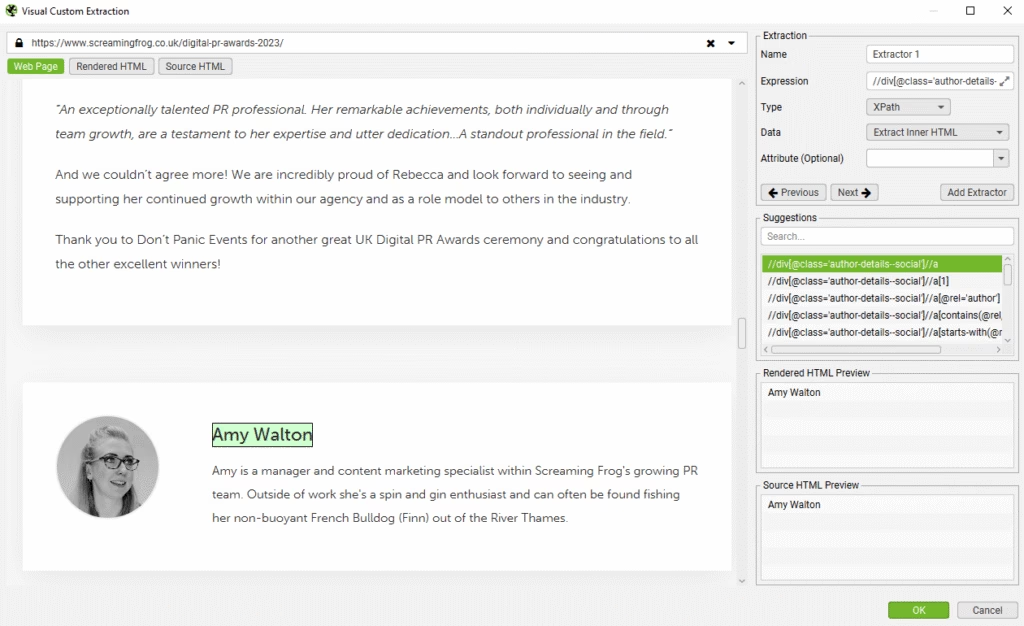
Common use cases span content audits, competitor analysis, and compliance monitoring. E-commerce sites extract product prices, descriptions, and availability across thousands of pages. Publishing platforms collect author names, publication dates, and social sharing metrics from blog posts. Marketing teams verify tracking codes, meta tags, and structured data implementation across entire domains.
For example, a retail website extracts product titles using XPath to audit naming consistency. News sites collect article metadata to analyze publishing patterns. Digital agencies often extract email addresses using regex to audit contact information accuracy.
7. AI Integrations
Screaming Frog AI integrations connect the SEO Spider directly to leading artificial intelligence platforms (OpenAI, Google Gemini, Anthropic Claude, and Ollama). These integrations communicate with AI models during a crawl. Users access these AI provider integrations via Config > API Access > AI for semantic content analysis and semantic search.
The primary benefits include creating meta descriptions, image alt text, title tags, and more, utilizing the AI capabilities to automate and enhance content optimization tasks. Users also automate audits, analyze page intent, and generate content effortlessly after they connect their API keys.
Custom AI prompts enable tailored analysis across crawled websites. The Add from Library function includes half a dozen prompts for inspiration, and users add and customize their own prompts. Custom prompts are shared using the export and import buttons at the top of the interface. Multiple prompt targets allow different AI models to analyze the same data side by side.
Segment-based AI analysis processes specific website sections or page types differently. Users create targeted prompts for product pages, blog posts, or category pages to generate relevant optimization suggestions. This segmentation ensures AI responses match the unique requirements of different content types.
Users also utilize OpenAI and Gemini for image and text speech generation, which creates hero images for blog posts during crawls. The SEO Spider shows an image or sound preview in the UI, which users expand or listen to for immediate feedback.
Users configure AI integrations through the API Access menu after they obtain API keys from their chosen providers. The system processes prompts against crawl data in real-time and displays results in dedicated AI tabs alongside standard SEO metrics.
8. API Integrations
API integrations in Screaming Frog extend the crawler with external data sources to provide comprehensive SEO analysis. Screaming Frog gives the ability to integrate data from Google Analytics, Google Search Console, Majestic, Page Speed Insights, Moz, and Ahrefs with data from crawling. Users connect to the Google Analytics, Search Console, and PageSpeed Insights APIs and fetch user and performance data for all URLs in a crawl for greater insight.
Google Analytics integration imports traffic metrics, user behavior data, and conversion information directly into crawl results. Users view page views, bounce rates, and user engagement metrics alongside technical SEO data. This combination reveals which technical issues impact actual user traffic and behavior patterns.
Google Search Console integration provides search performance data, including impressions, clicks, and ranking positions for crawled URLs. Users may choose to select a specific country or a device after they configure the integration. The system matches crawl data with search visibility metrics to identify optimization opportunities.
PageSpeed Insights fetches Core Web Vitals scores, performance recommendations, and loading speed data for each crawled page. Users identify pages with poor performance metrics that require technical optimization.
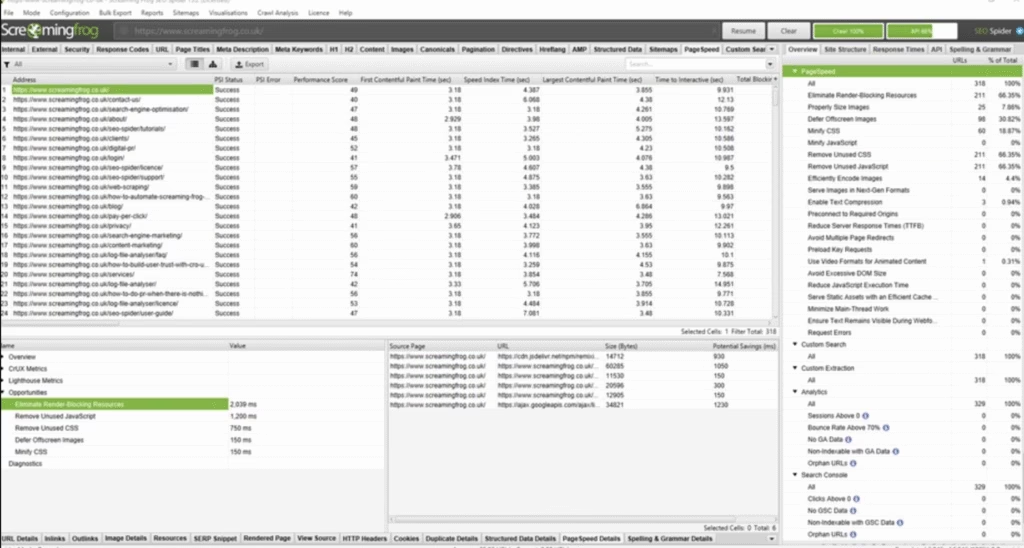
API-only mode eliminates the need for traditional website crawling and focuses entirely on data retrieval through connected APIs. Users analyze existing URL lists or XML sitemaps without performing resource-intensive crawls. This approach saves time and server resources when comprehensive crawling is unnecessary.
9. Visualization and Reporting
Visualization and reporting in Screaming Frog transform complex crawl data into visual representations that reveal site architecture patterns and technical issues. Site architecture visualization uses diagrams and tree graphs to evaluate internal linking structures and URL hierarchies. The circles represent pages, and the lines connecting these circles represent the links between pages.
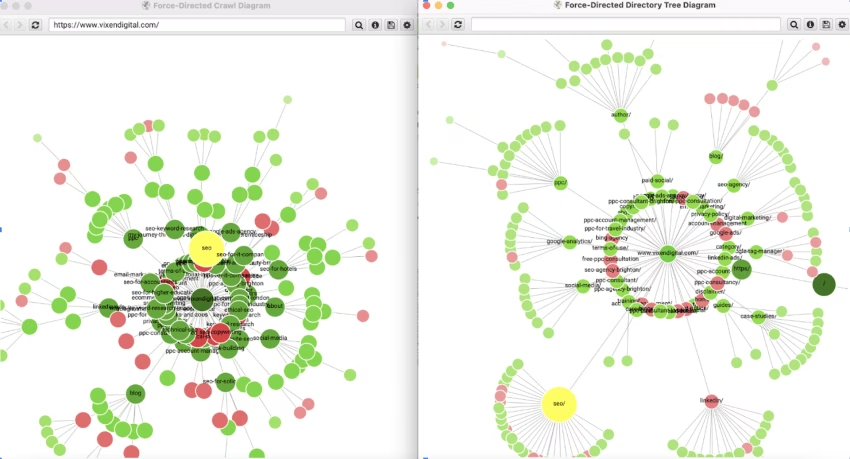
Force-directed crawl diagrams function like heat maps, with the start URL represented by the darkest green, largest node in the middle. Users go to Visualizations and then Force-Directed Crawl Diagram after they want to see a visualization of their crawl. Users run the Force-Directed Crawl Diagram, click on Settings, and choose GSC clicks to color pages with the most clicks darker green.
Content cluster diagrams organize related pages and topics within the site structure. The 3D Force Directed Crawl Diagram allows analysis of link distribution visually by displaying the strength and directionality of internal links. Users identify potential areas of link equity loss or concentration through these visual representations.
The crawl comparison functionality enables users to analyze changes between different crawl sessions. This feature highlights new issues, resolved problems, and structural modifications that occur between website audits.
The Looker Studio tab allows users to export a timeseries report to Google Sheets that connects to Looker Studio. This feature automatically appends new scheduled exports to a new row in the same sheet in a time series.
10. Mobile and Accessibility
Mobile and accessibility features in Screaming Frog address critical usability requirements for modern websites. Mobile now accounts for over 60% of worldwide traffic, making mobile usability more important than ever for delivering an inclusive experience to all users. Screaming Frog helps ensure mobile and accessibility compliance by checking and reporting on various factors, such as viewport configuration, device compatibility, rendering issues, and accessibility errors.
Mobile usability testing examines websites through mobile-specific perspectives and identifies mobile-related issues. The feature affects search engine rankings and plays a significant role in user satisfaction. The tool checks viewport configurations, touch element sizing, and mobile-specific content rendering problems that impact user experience on mobile devices.
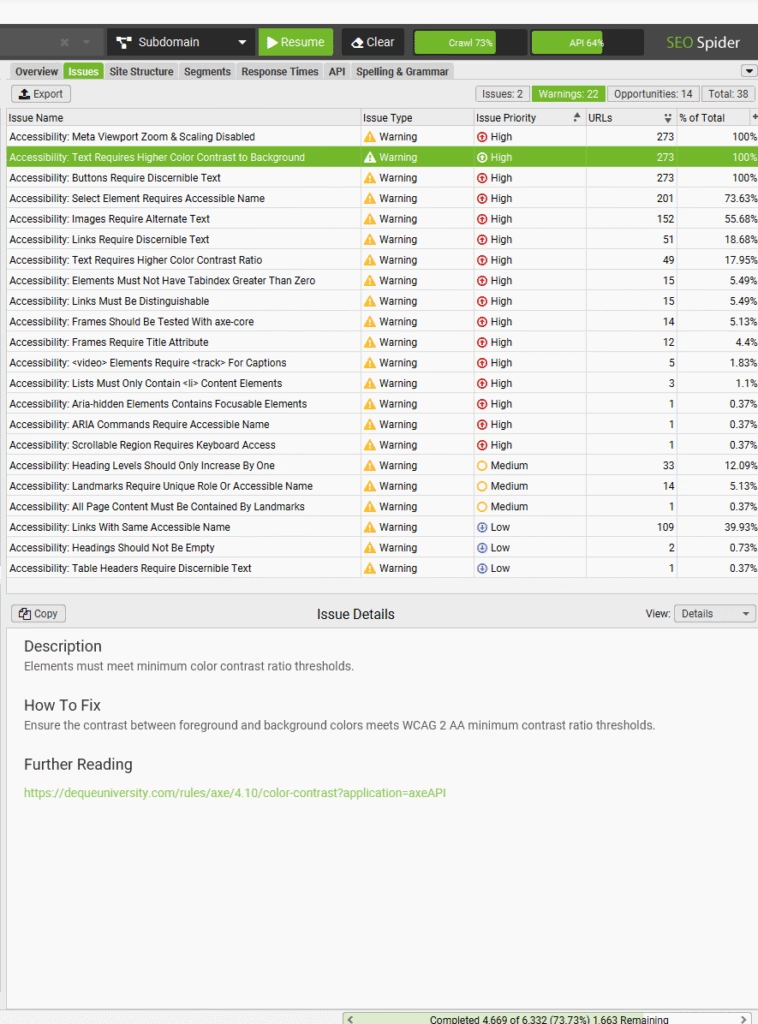
Accessibility auditing improves site accessibility to make sites more inclusive and user-friendly for people with disabilities. The tool runs automated accessibility audits using the integrated AXE engine for automated accessibility validation. This engine powers Lighthouse accessibility checks and identifies WCAG compliance issues across crawled pages.
Responsive crawling capabilities allow users to switch the user-agent of the HTTP requests made by the SEO Spider. The SEO Spider has inbuilt preset user-agents for Googlebot, Bingbot, various browsers, and more. The tool tests and previews pages on different devices and screen sizes to identify responsive design issues.
How does Screaming Frog SEO Spider Work?
Screaming Frog works like a robot that runs on your desktop computer and visits every page on a website automatically. You download and install the software on your Windows, Mac, or Ubuntu computer first. You give it a starting webpage address, and it begins reading that page from your desktop. The tool finds all the links on that first page and follows each one to discover more pages.
The desktop robot continues this process by visiting each new page it finds, reading the content, and following more links. It keeps going until it has visited every page connected to your website. The tool examines each page for problems like broken links, missing descriptions, or slow loading times.
All the information appears on your desktop screen in organized sections, including lists of pages with problems, pages that work correctly, and detailed reports about what needs fixing.
How Accurate is Screaming Frog SEO Spider Tool?
Screaming Frog SEO Spider Tool delivers highly accurate website analysis results. The tool precisely replicates Googlebot behavior, crawling and analyzing websites exactly as Google does. This ensures discovered issues match what search engines actually see.
The software supports JavaScript rendering capabilities, processing dynamic content that loads after initial page load. Users exercise granular control over crawling parameters. API integrations enrich crawl data with external sources like Google Analytics, Search Console, and PageSpeed Insights. These integrations provide deeper insights by combining technical crawl data with real performance metrics.
The desktop software has no limits like online tools do. Users are enabled to check unlimited websites without waiting or restrictions after they buy a license. This makes the tool very accurate for thorough website testing.
What Pricing Plans Does Screaming Frog Tool Offer?
Screaming Frog offers both free and paid versions to accommodate different user needs and budgets. There is no such thing as a Screaming Frog free trial, but the free version serves this purpose. The free version allows crawling up to 500 URLs, making it suitable for small websites and basic SEO audits.
The paid version costs $279 per year and removes the 500 URL crawl limit, providing unlimited crawling capabilities. This license unlocks advanced features including custom extraction, API integrations, JavaScript rendering, crawl scheduling, and data export options. Organizations requiring multiple users need separate licenses.
The Screaming Frog pricing structure offers volume discounts. 5-9 licenses cost $265 each, 10-19 licenses cost $249 each, and 20+ licenses cost $235 each annually. The prices of Screaming Frog make the tool accessible for agencies and large teams managing multiple websites.
Screaming Frog is typically worth it for SEO professionals and website owners. The tool combines comprehensive crawling capabilities, accurate technical analysis, and extensive integrations. The Screaming Frog license cost represents minimal expense compared to hiring consultants or using multiple separate tools.
What is the Screaming Frog Tool Rating?
Screaming Frog reviews vary between major review sites, with an average rating of 4.5 out of 5. The ratings for major sites are listed below.
- Trustpilot. 3.2 / 5 (9 reviews)
- TrustRadius. 9.3 / 5 (97 reviews)
- Capterra. 4.9/ 5 (132 reviews)
- G2. 4.7 / 5 (96 reviews)
- Software Advice. 4.9/ 5 (132 reviews)
The consistently high ratings on business platforms demonstrate strong satisfaction among SEO professionals who praise the tool’s crawling capabilities and desktop-based reliability. However, users have to combine Screaming Frog with other platforms for a full toolkit.
What are the Pros of Screaming Frog?
The pros of Screaming Frog include its precise and comprehensive technical SEO features. Screaming Frog benefits are listed below:
- Free Version. Users are able to access core crawling functionality up to 500 URLs without cost, making it accessible for small websites and testing purposes.
- Diverse Integrations. Connects with Google Analytics, Search Console, PageSpeed Insights, and third-party APIs for enriched data analysis and comprehensive insights.
- Accurate Data. Precisely mimics Googlebot behavior and supports JavaScript rendering, ensuring crawl results match what search engines actually see.
- Frequently Updated. Regular software updates add new features, improve performance, and maintain compatibility with evolving web technologies and search engine changes.
- Customizable Crawls. Offers granular control over crawling parameters, custom extraction rules, and flexible configuration options for specific audit requirements.
Screaming Frog provides exceptional value for SEO professionals seeking comprehensive technical website analysis. The desktop architecture and unlimited crawling capabilities stand out as particularly strong components. However, the tool requires technical knowledge.
What are the Cons of Screaming Frog?
The cons of Screaming Frog are mostly related to its technical complexity and desktop-only nature rather than comprehensive SEO strategy features. The cons of Screaming Frog are listed below:
- Limited Free Version. The free version restricts crawling to 500 URLs, making it inadequate for medium to large websites that need comprehensive analysis.
- Steep Learning Curve. New users face significant challenges understanding the interface, configuring crawls properly, and interpreting technical data without SEO experience.
- Difficult Interface. The desktop application interface feels outdated and overwhelming, with numerous tabs, filters, and technical options that confuse beginners.
- Technical Knowledge Requirements. Advanced features like custom extraction, XPath expressions, and API integrations require technical expertise that many users lack.
- Desktop-Only Limitation. Users must install software locally, preventing cloud-based collaboration and making it difficult to share live crawl data with team members.
- No Content Strategy Features. The tool focuses solely on technical SEO analysis and lacks content optimization, keyword research, or competitive analysis capabilities.
Screaming Frog works well for technical SEO auditing, but falls short for users needing comprehensive SEO strategy tools. The software’s complexity and technical focus become barriers for beginners and teams requiring collaborative workflow features.
What do Reddit users think about Screaming Frog?
Reddit users generally view Screaming Frog positively as a valuable SEO tool, though they note some practical considerations. The SEO community appreciates it as a tool that provides raw technical data without the interpretive layer of premium audit platforms, which offers flexibility for experienced users. However, beginners often require the interpretation and recommendation common with other tools.

The learning process requires some initial investment for newcomers to the platform. Users recommend seeking tutorials to maximize the tool’s potential, as understanding the various crawl modes, like XML sitemap crawls and list mode, helps achieve better results. Once users become familiar with the interface, they find it quite powerful.

Users occasionally encounter technical considerations during usage. Sites with security measures, firewalls, or Cloudflare protection may require additional configuration steps. The free version includes a 500-page crawl limit, which works well for smaller sites but sometimes requires upgrading for larger projects. JavaScript-heavy websites sometimes need adjustments like user agent modifications or private browsing sessions for optimal crawling.

Performance considerations become relevant for extensive projects. Users note that very large sites exceeding 250,000 pages may benefit from alternative solutions or additional server resources. The tool performs optimally on server-grade hardware rather than basic laptops, particularly for comprehensive audits.

Experienced users praise the tool’s flexibility and comprehensive data extraction capabilities, particularly valuing its ability to provide detailed technical insights when properly configured for their specific use cases.
How does Screaming Frog treat its long-term subscribers?
Screaming Frog treats its long-term subscribers well, but there are no special discounts or perks for people who are long-term subscribers. All users pay the same price for the same tool, without exception. There have been two price increases in 15 years since the company’s launch in 2010. Screaming Frog allows license transfers if the original user leaves the company. It offers discounts for bulk purchases of 5 or more licenses.
How responsive is Screaming Frog’s customer support?
Screaming Frog support is responsive for paid users. They aim to respond within 24 hours during business hours, as long as users provide the required log files, issue details, and relevant screenshots or videos. Screaming Frog encourages users to first check the Getting Started guide, FAQ, and User Guide, and to ensure they use the latest version of the SEO Spider. Full support applies only to licensed users.
How reliable and legit is Screaming Frog as an SEO tool?
Screaming Frog is a reliable and legitimate SEO tool trusted by professionals, agencies, and enterprises for over a decade. It delivers accurate and in-depth technical SEO data, including crawl errors, redirects, duplicate content, and internal linking issues. The tool receives regular updates, offers transparent licensing, and provides timely support to paid users.
What is the best alternative to the Screaming Frog tool?
Search Atlas is the best alternative to Screaming Frog because it offers precise technical auditing and crawling, but with automated fixes and recommendations that make the tool more approachable to users. Search Atlas fixes SEO problems automatically instead of just finding them.
The platform offers comprehensive site audits, interactive visualization, real-time monitoring, and one-click technical fixes. Its unique Crawl Monitoring dashboard tracks multi-bot activity across Google, Bing, GPTBot, ClaudeBot, and other engines in a unified view, providing competitive insights into how bots interact with your site. Search Atlas provides a full search toolkit along with technical SEO tools, including content, link building, on-page, digital PR, and PPC toolkit.
OTTO SEO monitors your site 24/7, fixes SEO issues with one click, and automatically creates blog posts, product pages, and metadata. It connects directly to Google Search Console, Analytics, and ad platforms. Migrate from Screaming Frog to Search Atlas for automated SEO fixes and a full set of search tools.
Are there any other Screaming Frog alternatives?
Yes, there are other Screaming Frog alternatives. The alternatives include Sitebulb, Lumar, Botify, OnCrawl, and SE Ranking. Most of these Screaming Frog alternatives focus on technical SEO and do not offer a full SEO toolkit.
Do SEO professionals rank Screaming Frog among the best SEO Tools?
Yes, SEO professionals rank Screaming Frog among the best SEO tools. The Screaming Frog SEO Spider is widely used for technical audits and often in combination with other SEO tools, as it is useful and accurate, but it works as a specialized tool, not a comprehensive platform.




